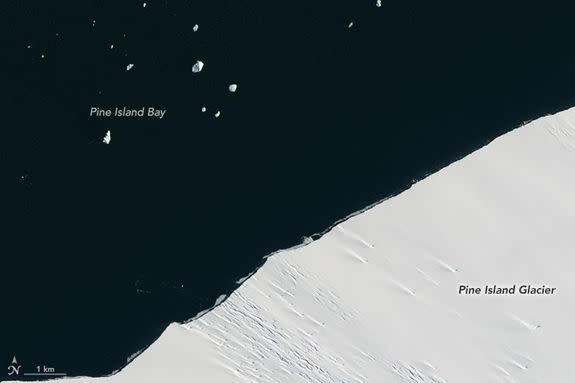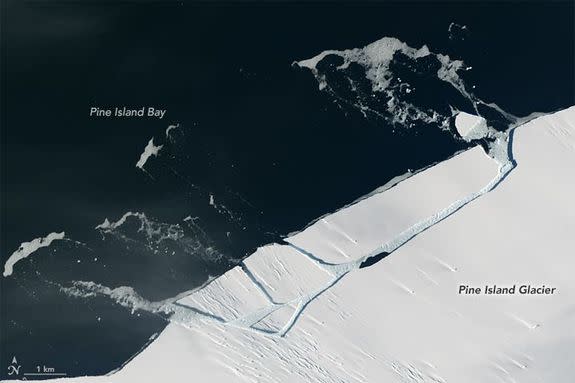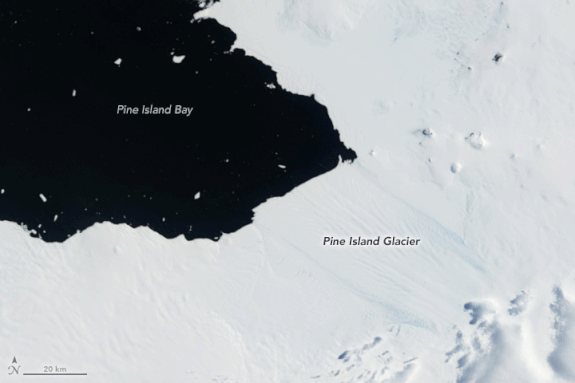Antarctica just shed a Manhattan-sized iceberg, and a bigger one is coming soon

An iceberg the size of Manhattan has cleaved off of Antarctica's rapidly melting Pine Island Glacier on the southwest coast of the continent. NASA released the new data showing the iceberg's birth on Feb. 15, though the imagery was acquired between Jan. 26 and Jan. 31.
The agency says "about a kilometer or two of ice" broke off the glacier's floating ice shelf during this period, making it a large iceberg but comparitively small in the recent history of this particular area.
SEE ALSO: This 'GOT' star teamed up with Google to capture Greenland's melting ice
According to Ian Howat, a glaciologist at Ohio State University, the event was about 10 times smaller than the chunk of ice that broke off the same glacier in July 2015, when a 20-mile, or 30-kilometer, rift developed and calved an iceberg spanning 225 square miles.
“I think this event is the calving equivalent of an ‘aftershock’ following the much bigger event,” Howat said in a press release.
“Apparently, there are weaknesses in the ice shelf — just inland of the rift that caused the 2015 calving — that are resulting in these smaller breaks.”

Image: nasa

Image: nasa
Despite its relatively small size, the new iceberg continues to point to the increasing instability of this glacier in particular, and is another warning sign regarding the fate of the much larger and more consequential West Antarctic Ice Sheet.
The Pine Island Glacier ends in a floating ice shelf which buttresses the land-based ice behind it. The new iceberg broke off this floating section, which means it by itself will not add to sea level rise.
@NASAEarth next iceberg is coming! pic.twitter.com/DTxC7UTesD
— Simon Gascoin (@sgascoin) February 15, 2017
Scientists are expecting more large icebergs to be born from this glacier, and are also anxiously watching the Larsen C Ice Shelf for what is likely to be one of the largest births of an iceberg on record during the next few months.
According to NASA, rifts on the Pine Island Glacier are present about 6 miles from the ice front, including a large one that was spotted in a scientific flight on Nov. 4, 2016. Some of the rifts are hard to see since they are extending upward from the bottom of the ice shelf.

Image: nasa
As Howat put it, the glacier's ice shelf is essentially breaking apart from the inside out.
“Such ‘rapid fire’ calving does appear to be unusual for this glacier,” Howat said. This phenomenon, which yields smaller glaciers, “fits into the larger picture of basal crevasses in the center of the ice shelf being eroded by warm ocean water, causing the ice shelf to break from the inside out,” he said.
What is happening to the Pine Island Glacier is not an isolated incident, either. Glaciers that end in floating ice shelves are melting at increasing rates in many other parts of Antarctica, Greenland, Canada and other areas.
SEE ALSO: One of the largest icebergs ever seen is even closer to breaking off Antarctica
Such melting from below due to an influx of relatively warm waters potentially dooms seemingly stable ice far inland, since it removes the plugs that had been preventing such glaciers from flowing faster into the sea.
Over time, ice shelves are retreating closer to their grounding line, which is where the ice begins to float. The grounding line at Pine Island has been retreating at one of the fastest rates of any glacier on Antarctica, which suggests a growing instability there.
Scientists have warned that the West Antarctic Ice Sheet may have entered a period of irreversible (albeit long-term) collapse, which could cause sea levels to rise by more than a meter, or 3.4 feet, by 2100 and a far greater amount thereafter, according to a March study published in the journal Nature. That study projected an astonishing 15 meters, or 50 feet of sea level rise by the year 2500, due to the collapse of the West Antarctic Ice Sheet.
By the middle of the 22nd century, the rate of sea level rise could exceed a foot per decade. This could render coastal megacities worldwide, from New York to Dhaka, virtually unlivable.
